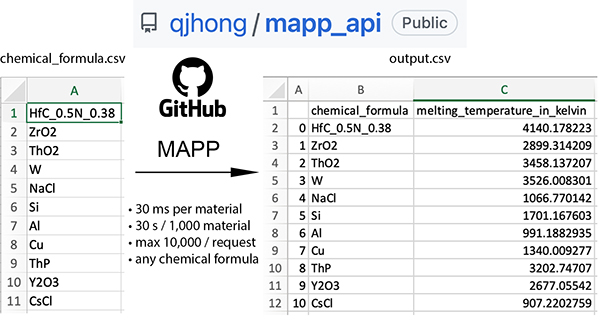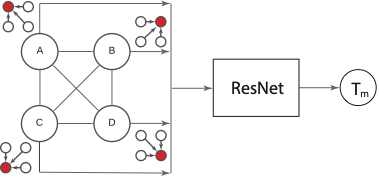Melting Temperature Predictor
Ensemble of 30 GNN models, accepts up to 4 elements

Cite this model:
Qi-Jun Hong, A melting temperature database and a neural network model for melting temperature prediction, arXiv, 2021. Download.
Qi-Jun Hong, Sergey V Ushakov, Axel van de Walle, and Alexandra Navrotsky, Melting temperature prediction using a graph neural network model: From ancient minerals to new materials, PNAS, 2022. Download.
This model is currently deployed on Microsoft Azure and the Research Computing facilities at ASU. Due to network limit, computation may take up to 10 seconds.
Important things to note:
Model Scope: This particular model is designed to handle chemical formulas containing up to four elements. If you require support for formulas with more elements, I recommend trying our six-element model, which is available at our website Version 2.1. It’s important to note that the complexity of the six-element model leads to increased susceptibility to overfitting.
Temperature Prediction: It’s crucial to understand that this model doesn’t predict solidus or liquidus temperatures. The dataset underlying this model predominantly consists of compounds with congruent melting temperatures. As a result, the “melting temperature” generated by this model is interpreted as the higher end of the solidus-liquidus temperature range. This interpretation similarly applies to compounds that decompose prior to melting.
Structure: To ensure simplicity and boarder applicability, this model relies solely the chemical formula as input; no structural information is required. Therefore, the predicted melting temperature should be understood as pertaining to the stable structure.
MAPP API
Use the MAPP API to run batch calculations. Visit GitHub.
Feedback
Metrics
R2 training score: 0.995
R2 testing score: 0.98
Root mean square error, training: 51K
Root mean square error, testing: 100K
What is new
Version 2: add uncertainty. ensemble of 30 deep learning models.
Version 1: melting temperature. GNN model.
Other versions
About this model
